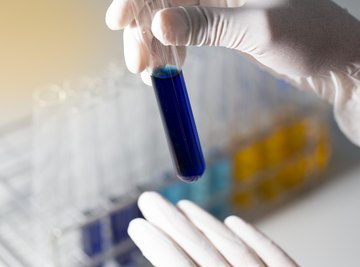
When citing the strength of an acid, chemists often use the dissociation constant, Ka, but this number can vary by several orders of magnitude from one acid to another. To create a more manageable number, chemists define the pKa value as the negative logarithm of the Ka value: pKa = -log Ka. If you already know the pKa value for an acid and you need the Ka value, you find it by taking the antilog. In practice, this means raising both sides of the equality to exponents of 10.
Definition of Ka
In the Bronsted-Lowry formulation of acids in solution, the acid donates a proton and the solution accepts one. The solution becomes one containing a conjugate base – which is the product of the acid having lost a proton – and a conjugate acid. Theoretically, this reaction can happen in both directions. When the solvent is water, this is written as:
HA + H2O <==> H3O+ + A-
It's possible to determine this strength of the original acid by dividing the concentrations of the conjugate acid and base by the concentrations of the original acid and base. When the solvent is water, it's left out of the equation. This operation gives you the dissociation constant Ka:
Ka=[H3O+][A-]/[HA]
When Ka is large, it means the conjugate ions aren't strong enough to move the reaction in the opposite direction, which indicates a strong acid.
pKa Makes Things Easier
The dissociation constant for a strong acid can be as high as 107, while for a weak acid it can be as low as 10-12. To create a more manageable number, chemists created the pKa value:
pKa = -log Ka
A strong acid with a dissociation constant of 107 has a pKa of -7, while a weak acid with a dissociation constant of 10-12 has a pKa of 12. Besides being easier to work with, pKa values have an inverse relationship to acid strength. In other words, a low pKa indicates a strong acid and vice versa.
Converting From pKa to Ka
In some tables, you may find the pKa value listed, but you may need the Ka value to plug into your equations. The mathematical operation you perform is Ka = antilog (-pKa). You solve this by raising both sides of the original relationship to powers of 10 to get:
Ka = 10(-pKa)
When pKa is a whole number, such as -7, this operation is easy to perform, but when it contains a fraction, such as 7.5, you may have to look up the value in a table. You can also find it on a scientific calculator by inputting the number and pressing the exponent key, which either looks like a hat (^) or is denoted by 10x. Remember that pKa is expressed as a common logarithm (base 10) and not as a natural logarithm (base e), so you want to find a table or select a function on your calculator that raises the number to a power of 10 rather than a power of e.
References
About the Author
Chris Deziel holds a Bachelor's degree in physics and a Master's degree in Humanities, He has taught science, math and English at the university level, both in his native Canada and in Japan. He began writing online in 2010, offering information in scientific, cultural and practical topics. His writing covers science, math and home improvement and design, as well as religion and the oriental healing arts.
